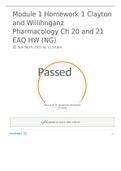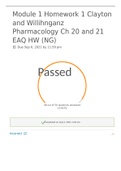Eaq pharmacology - Study guides, Class notes & Summaries
Looking for the best study guides, study notes and summaries about Eaq pharmacology? On this page you'll find 59 study documents about Eaq pharmacology.
Page 4 out of 59 results
Sort by
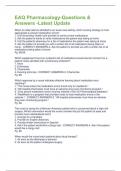
-
NU271 HESI Case Study: Fluid Balance (week 10) Updated 2024-2025
- Exam (elaborations) • 22 pages • 2024
-
- $17.99
- + learn more
NU271 HESI Case Study: Fluid Balance (week 10) Updated Client's serum potassium is low. She needs potassium replacement via IV solution instead of the PO route. A prescription for potassium chloride diluted in an IV solution to be administered over several hours should be obtained from the healthcare provider. In addition, the patient has an order for potassium wasting diuretic. Which lab values are most important for the nurse to monitor? (Select all that apply.) - CORRECT ANSWERS-Ser...
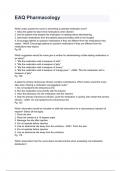
-
EAQ Pharmacology questions and answers rated A+ by experts 2024/2025
- Exam (elaborations) • 21 pages • 2024
- Available in package deal
-
- $9.99
- + learn more
EAQ Pharmacology questions and answers rated A+ by experts 2024/2025
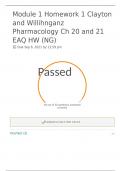
-
Module 1 Homework 1 Clayton and Willihnganz Pharmacology Ch 20 and 21 EAQ HW (NG)
- Exam (elaborations) • 6 pages • 2024
-
- $11.39
- + learn more
Module 1 Homework 1 Clayton and Willihnganz Pharmacology Ch 20 and 21 EAQ HW (NG) Due Sep 6, 2021 by 11:59 pm 48 out of 50 questions answered correctly Incorrect (2) Calculate the body mass index (BMI) of a patient whose height and weight are 66 inches (167.7 cm) and 125 pounds (56.7 kg) respectively. Rationale Calculate the body mass index by dividing the patient’s weight in pounds by his or her height in inches squared and multiplying th...
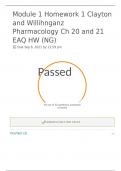
-
Module 1 Homework 1 Clayton and Willihnganz Pharmacology Ch 20 and 21 EAQ HW (NG)
- Exam (elaborations) • 6 pages • 2024
-
- $12.79
- + learn more
Module 1 Homework 1 Clayton and Willihnganz Pharmacology Ch 20 and 21 EAQ HW (NG) Due Sep 6, 2021 by 11:59 pm 48 out of 50 questions answered correctly Incorrect (2) Calculate the body mass index (BMI) of a patient whose height and weight are 66 inches (167.7 cm) and 125 pounds (56.7 kg) respectively. Rationale Calculate the body mass index by dividing the patient’s weight in pounds by his or her height in inches squared and multiplying th...
Module 1 Homework 1 Clayton and Willihnganz Pharmacology Ch 20 and 21 EAQ HW (NG)
Module 1 Homework 1 Clayton and Willihnganz Pharmacology Ch 20 and 21 EAQ HW (NG)
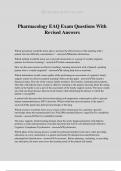
-
Pharmacology EAQ Exam Questions With Revised Answers
- Exam (elaborations) • 3 pages • 2024
-
- $10.49
- + learn more
Pharmacology EAQ Exam Questions With Revised Answers Which precaution would the nurse take to increase the effectiveness of the teaching with a patient who has difficulty concentration ? - answerMinimize distractions. Which method would the nurse use to provide instructions to a group of visually impaired patients for effective learning? - answerVerbal communication. How can the nurse ensure an effective teaching- learning interaction with a Spanish- speaking patient who is visually impai...

-
Module 1 Homework 1 Clayton and Willihnganz Pharmacology Ch 20 and 21 EAQ HW (NG)
- Exam (elaborations) • 6 pages • 2024
-
- $12.09
- + learn more
Module 1 Homework 1 Clayton and Willihnganz Pharmacology Ch 20 and 21 EAQ HW (NG) Due Sep 6, 2021 by 11:59 pm 48 out of 50 questions answered correctly Incorrect (2) Calculate the body mass index (BMI) of a patient whose height and weight are 66 inches (167.7 cm) and 125 pounds (56.7 kg) respectively. Rationale Calculate the body mass index by dividing the patient’s weight in pounds by his or her height in inches squared and multiplying th...
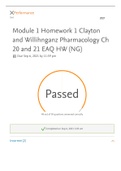
-
Module 1 Homework 1 Clayton and Willihnganz Pharmacology Ch 20 and 21 EAQ HW (NG)
- Exam (elaborations) • 42 pages • 2022
-
- $8.99
- + learn more
Calculate the body mass index (BMI) of a patient whose height and weight are 66 inches (167.7 cm) and 125 pounds (56.7 kg) respectively. Rationale Calculate the body mass index by dividing the patient’s weight in pounds by his or her height in inches squared and multiplying the result by a conversion factor of 703. Squaring the height of 66 inches (167.7 cm) yields a value of 4356. Dividing the weight of 125 pounds (56.7 kg) by the squared height and then multiplying by 703 gives a bod...
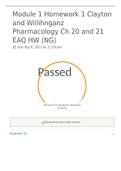
-
Module 1 Homework 1 Clayton and Willihnganz Pharmacology Ch 20 and 21 EAQ HW (NG)
- Exam (elaborations) • 6 pages • 2022
-
- $15.49
- + learn more
Module 1 Homework 1 Clayton and Willihnganz Pharmacology Ch 20 and 21 EAQ HW (NG) Due Sep 6, 2021 by 11:59 pm 48 out of 50 questions answered correctly Incorrect (2) Calculate the body mass index (BMI) of a patient whose height and weight are 66 inches (167.7 cm) and 125 pounds (56.7 kg) respectively. Rationale Calculate the body mass index by dividing the patient’s weight in pounds by his or her height in inches squared and multiplying th...

How did he do that? By selling his study resources on Stuvia. Try it yourself! Discover all about earning on Stuvia

